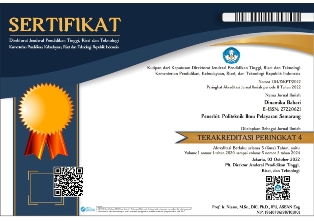Terlambatnya Proses Pendinginan Muatan Gas Polymer Grade Propylene di Kapal LPG/C Coral Millepora
Abstract
The LPG Carrier is one of the ships that carries liquid gas cargoes below -48o C. The LPG Carrier has facilities in the form of a reliquefaction plant that uses seawater as a coolant for gas cargo. Therefore, the reliquefaction plant has an important role in the smooth loading and unloading process. If one of the reliquefaction plant particles is damaged, of course the cooling process of the polymer grade propylene gas load will be hampered. The purpose of this study is to describe the problem in the cooling process of polymer grade propylene load. The authors conducted research using a qualitative descriptive method through an interview approach, direct observation of the object of research, and supported by paper-based documents or photos. Based on the results of the study, it was found that the causes of delays in the cooling process of polymer grade propylene gas cargo, namely the influence of weather, sea water content, clogged sea water filters, clogged condenser tubes, and condenser shell tube leaks.
Downloads
References
Barus, M. D., Asyrafy, H., Nababan, E., & Mawengkang, H. (2018). Routing and Scheduling Optimization Model of Sea Transportation. IOP Conference Series: Materials Science and Engineering. IOP Publishing Ltd.
Brauers, H., Braunger, I., & Jewell, J. (2021). Liquefied natural gas expansion plans in Germany: The risk of gas lock-in under energy transitions. Energy Research & Social Science, Vol. 76.
Dalaba, M., Alirigia, R., Mesenbring, E., Coffey, E., Brown, Z., Hannigan, M., et al. (2018). Liquified Petroleum Gas (LPG) Supply and Demand for Cooking in Northern Ghana. EcoHealth, Vol. 15, 716-728.
E. Poling, B., M. Prausnitz, J., & P. O’Connell, J. (2006). Properties of Liquids and Gases. Prandtl’s Essentials of Fluid Mechanics, 5, 17–45. https://doi.org/10.1007/0- 387-21803-3_2
Hisham A. Maddah. (2016). Polypropylene as a Promising Plastic: A Review. American Journal of Polymer Science, January. https://doi.org/10.5923/j.ajps.20160601.01
Kukuljan, D., Bernecic, D., & Orovic, J. (2012). The LNG reliquefaction plant - Operating principle and justifiability of its installation on board ships. 26. 215-226.
Laciak, M., Sztekler, K., & Szurlej, A. W. (2019). Possibilities of Liquefied Natural Gas (LNG) use for power generation. IOP Conference Series: Earth and Environmental Science. Vol. 214. Krakow, Poland: IOP Publishing Ltd.
Lovell-Smith, J., Feistel, R., Harvey, A., Hellmuth, O., Bell, S., Heinonen, M., et al. (2016). Metrological challenges for measurements of key climatological observables, Part 4: Atmospheric relative humidity. Metrologia, Vol. 53(1).
Ohashi, K., Kobayashi, K., Fujiii, H., & Watanabe, M. (2020). Evaporation coefficient and condensation coefficient of vapor under high gas pressure conditions. Scientific Reports, Vol. 10 (8143).
Shi, X. (2016). Gas and LNG pricing and trading hub in East Asia: An introduction. Natural Gas Industry B, Vol. 3 (4) , 352-356.
Zahno, M., Michaelowa, K., Dasgupta, P., & Sachdeva, I. (2020). Health awareness and the transition towards clean cooking fuels: Evidence from Rajasthan. PLoS ONE 15(4).
Zhuang, Y., Li, Y., & Su, W. (2016). Influence of Anchoring on Burial Depth of Submarine Pipelines. PLoS ONE 11(5).














